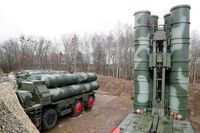In a dramatic escalation of hostilities, Indian armed forces have successfully thwarted multiple drone and missile attacks launched by Pakistan, showcasing the effectiveness of India's advanced air defense systems. The recent clashes follow the tragic killing of 26 tourists in Pahalgam, India, by Pakistan-backed terrorists, prompting a swift military response from India.
On May 7, 2025, India initiated Operation Sindhoor, during which missiles and drones were deployed to eliminate nine terrorist hideouts in Pakistan and Pakistan-occupied Kashmir. This operation was a direct retaliation for the earlier attack on innocent civilians, and it marked a significant shift in India’s military strategy, leveraging cutting-edge technology to counter threats.
In response to Operation Sindhoor, Pakistan launched a counter-offensive on May 7 and 8, targeting 15 Indian cities, including Srinagar, Amritsar, and Ludhiana, with drones and missiles. However, India's S-400 Triumf air defense system proved to be a formidable barrier, intercepting every attack and leaving Pakistan unable to achieve its objectives.
The S-400, often referred to as the "Sudarshan Chakra" by Indian forces, has been described as the world's best air defense system. It is capable of detecting threats up to 600 kilometers away and can track 300 targets while engaging 36 simultaneously. This multi-layered defense system includes four types of missiles, each designed to tackle different aerial threats effectively.
The S-400's capabilities include:
- 40N6E: With a range of 400 kilometers, it targets AWACS, tankers, and strategic bombers, capable of destroying targets deep within Pakistan.
- 48N6DM / 48N6E3: This missile has a range of 250 kilometers and is effective against fighter jets and cruise missiles.
- 9M96E2: Aimed at agile jets and drones, this missile has a range of 120 kilometers.
- 9M96E: This short-range interceptor targets low-flying drones and helicopters, with a range of 40 kilometers.
These missiles create a comprehensive air defense dome over India, safeguarding against a range of aerial threats from stealth jets to hypersonic missiles. The S-400's radar systems, including the 91N6E Big Bird and 92N6E Grave Stone, detected Pakistani attacks from as far as 340 kilometers away, allowing for timely interceptions.
During the initial wave of attacks on May 7, the S-400 system was deployed with remarkable efficiency, achieving a near 80% hit rate in real-world tests. Its deployment time is under five minutes, allowing it to respond rapidly to incoming threats. Even attempts to jam its radar systems were unsuccessful, demonstrating the advanced technology behind the S-400.
India's military response did not stop with the S-400. On the night of May 8, Indian forces shot down over 50 swarm drones launched by Pakistan across the Line of Control and the International Border, further highlighting the effectiveness of India's layered air defense strategy. This operation was accompanied by multiple ceasefire violations, particularly in Jammu and Kashmir, where the Indian Army confirmed the engagement of air defense assets in various locations.
The Indian Army's statement on X confirmed, "The drone attacks were effectively repulsed, and a befitting reply was given to the ceasefire violations." This highlights the military's readiness and capability to respond to aerial threats swiftly.
India's air defense arsenal is considered superior to Pakistan's, bolstered by a mix of Russian, Israeli, and indigenous systems. Key components of India's air defense include:
- S-400 Triumf: A long-range system with a 380-kilometer range, three squadrons of which have already been deployed.
- Barak-8 MR-SAM: Developed jointly with Israel, this system has a range of over 70 kilometers.
- Akash Missile System: An indigenous system effective within 25 kilometers.
- Spyder: An Israeli system providing quick-reaction, low-level protection.
- Shorter-range systems: Including the Russian Igla-S and the Pechora systems.
Pakistan, on the other hand, relies heavily on Chinese-supplied HQ-9 missiles, which have a range of 120 to 300 kilometers, and French-origin Spada systems with a much shorter range.
This recent series of engagements underscores a significant shift in the nature of warfare in the region, particularly with the increasing use of drones. India's ability to intercept over 50 drones in a single night reflects the maturity of its air defense infrastructure and the importance of continued investment in anti-drone technologies.
As tensions continue to rise, the S-400 and other air defense systems remain pivotal in maintaining India's security against aerial threats. The successful interception of Pakistani missiles and drones not only protects military installations but also reassures civilians living in border areas.
In conclusion, the recent military operations and the effectiveness of India's air defense systems highlight the evolving landscape of modern warfare, where technology plays a crucial role in national security. As both nations navigate this complex situation, the stakes remain high, with the potential for further escalation looming on the horizon.




